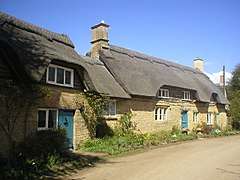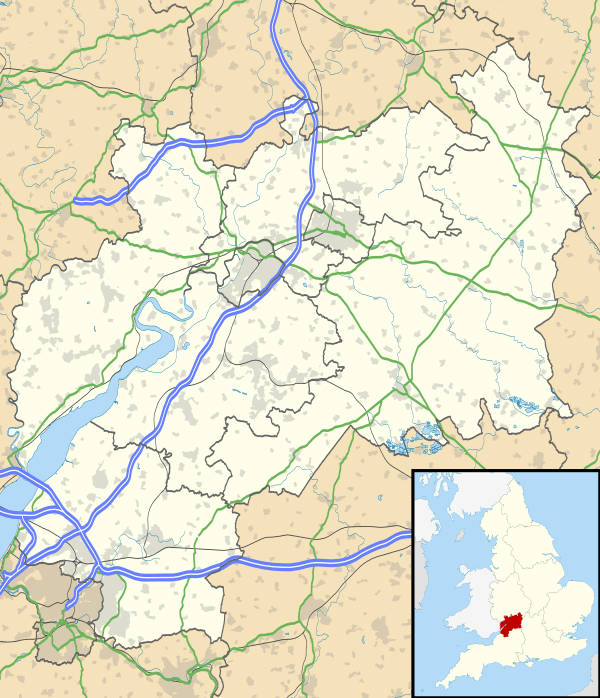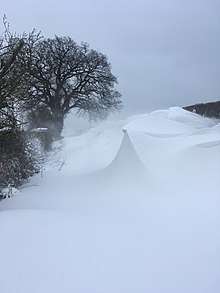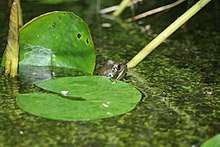Hidcote Bartrim
| Hidcote Bartrim | |
|---|---|
 Thatched cottages in Hidcote Bartrim | |
 Hidcote Bartrim Hidcote Bartrim shown within Gloucestershire | |
| Population | 21 |
| OS grid reference | SP1817642836 |
| District | |
| Shire county | |
| Region | |
| Country | England |
| Sovereign state | United Kingdom |
| Post town | CHIPPING CAMPDEN |
| Postcode district | GL55 6 |
| Police | Gloucestershire |
| Fire | Gloucestershire |
| Ambulance | South Western |
| EU Parliament | South West England |
Hidcote Bartrim is a small village or hamlet in the civil parish of Ebrington in the Cotswold district of Gloucestershire, England. The nearest town is Chipping Campden, which is approximately 2.75 miles (4.43 km) south-west from the village. The village is on the Gloucestershire-Warwickshire border. It should not be confused with Hidcote Boyce, a similarly sized village roughly 0.5 miles (0.80 km) south of Hidcote Bartrim.
Hidcote Manor Garden is one of the best-known and most influential Arts and Crafts gardens in Britain, with its linked "rooms" of hedges, rare trees, shrubs and herbaceous borders. Created by Lawrence Johnston,[1] it is owned by the National Trust and is open to the public.
Kiftsgate Court Gardens, created by Heather Muir in the 1920s,[2] is also adjacent to the village.
Other major attractions include the duck pond, the field with a tree in the middle and the so-called ‘avenue of trees’. The latter affords visitors beautiful views of the Warwickshire countryside from a raised vantage point, over 600 ft above sea level.
History
Hidcote Bartrim is named in the Domesday Book (1086), where it was held by the church of St Mary of Evesham.[3] There was one plough and two slaves in lordship and 3 hides (around 400 acres) returning 20 shillings taxable value, not a great deal. Population statistics for 1086 are lacking, although the wives of 4 villagers "who have recently died" have one plough, suggesting some sort of catastrophe in the village. The Abbot of St Mary gave the village to one his knights part of William I's military service.
Historic England records that Hidcote Manor was owned by Bradenstoke Priory in Wiltshire until the Priory was disbanded by Henry VIII in around 1539.[4]
The manor house was built in the 17th Century as a farmhouse. It passed through several hands before being inherited in early 1907 from the Freeman family by John Tucker, who had farmed there since 1873.
Within a couple of months of probate being granted the estate was put up for auction. It was advertised in The Times on 22 June 1907 as a ‘valuable freehold farm comprising 287 acres’. The land would be sold with a ‘very substantial and picturesque farm house…… with lawns and large kitchen garden’.
At the auction in July 1907, the bidding had reached £6,500, at which point it was withdrawn from sale. Three weeks later Lawrence Johnston, acting on behalf of his mother, agreed to purchase the estate from John Tucker for £7,200.
Etymology
The addition of ‘Bartrim’ and ‘Boyce’ to the Hidcote villages may refer to former tenants. ‘Boyce’ may refer to a record of a de Bois family,[5] whilst ‘Bartrim’ may be a corruption of ‘Bertram’,[6] a known English name.
Major goods and services
Approximately 15% of the population are concerned with academic or educational output, making this the most significant sector in the village, comprising arts, science and humanities in roughly equal share. This vastly exceeds the UK average.[7] This is illustrated in the figures for educational standards. Nearly 5% of the population of Hidcote Bartrim are educated to a doctoral level, which is over one hundred times the U.K. level of around 0.04%.[8][9] Around 10% of the local population are employed in local agriculture. Other notable employers include Jaguar Land Rover and Hidcote Manor Garden.
Tourism, retail and agriculture make up close to 100% of the village’s income, although textiles form a small yet important element of local trade.
Amenities
Hidcote Manor Garden offers a café, gift shop and second-hand book shed. They also maintain a small garden centre where flowers, shrubs, herbs and garden ornaments may be purchased.
Access
By road, there are three main routes to Hidcote Bartrim. Firstly, the village can be approached from the north by climbing Coleman's Hill. From the west Baker's Hill can be taken, and from the east a road can be taken from the larger Lark Stoke to Ebrington road, though this route is treacherous and poorly maintained.
Traffic in the village can be unusually congested for a settlement of this size, due to high visitor numbers at the two nearby gardens.

By foot, the Monarch's Way can bring visitors to the village either from the north via Admington or from the south via Chipping Campden. A bridleway from Ilmington also adjoins the aforementioned eastern route at the summit of Coleman's / Bakers Hill.[11]
Housing
The National Trust own all property in the village and act as landlord to each of the ten domestic dwellings. It is believed that these properties occupy an inalienable status, meaning that under the current National Trust regulations, they may not be sold.
There are ten dwellings, including two substantial farmhouses. Most of the smaller cottages have thatched roofs.
Demographics
The ethnic make-up of the population is, as of April 2018, as follows:
- White British: 100%
English is thought to be the first language of 100% of residents, with Welsh being the dominant second language.
Hair colour is predominantly blonde or brown, with a smaller community of redhead inhabitants.
Wildlife
Deer, foxes, badgers, squirrels, rabbits and other small mammals are common sights in Hidcote Bartrim, as well as frogs and a large variety of birds. Great crested newts and smooth newts are also common. An invasive species of ant, Lasius neglectus, is also present, which is frequently described as a pest by residents and has been identified as a major fire risk.[12]

Hidcote lavender, another name for Lavandula angustifolia, also takes its name from the village.[13]
References
- ↑ National Trust website
- ↑ Kiftsgate Court Gardens
- ↑ Opendomesday.org
- ↑ "History Of Hidcote". National Trust. Retrieved 2018-04-27.
- ↑ Speculative origin of the name Boyce
- ↑ Archive.org
- ↑ Universities UK
- ↑ weforum.org
- ↑ worldometers.info
- ↑ Feather Down Farms
- ↑ Map of the area
- ↑ Daily Telegraph
- ↑ Royal Horticultural Society